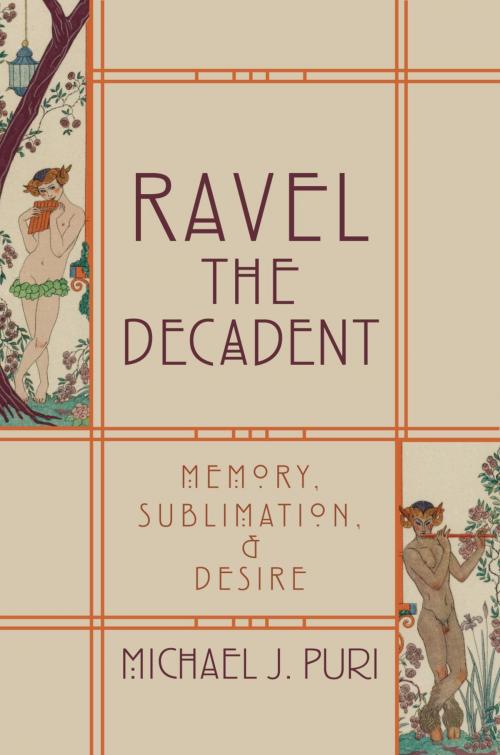Ravel the Decadent
Memory, Sublimation, and Desire
Nonfiction, Entertainment, Music, Theory & Criticism, Theory, History & Criticism, Reference| Author: | Michael J. Puri | ISBN: | 9780190453688 |
| Publisher: | Oxford University Press | Publication: | March 27, 2012 |
| Imprint: | Oxford University Press | Language: | English |
| Author: | Michael J. Puri |
| ISBN: | 9780190453688 |
| Publisher: | Oxford University Press |
| Publication: | March 27, 2012 |
| Imprint: | Oxford University Press |
| Language: | English |
The music of Maurice Ravel (1875-1937), beloved by musicians and audiences since its debut, has been a difficult topic for scholars. The traditional stylistic categories of impressionism, symbolism, and neoclassicism, while relevant, have offered too little purchase on this fascinating but enigmatic work. In Ravel the Decadent, author Michael Puri provides an innovative and productive solution by locating the aesthetic origins of this music in the French Decadence and demonstrating the extension of this influence across the length of his oeuvre. From an array of Decadent topics Puri selects three--memory, sublimation, and desire--and uses them to delineate the content of this music, pinpoint its overlap with contemporary cultural discourse, and link it to its biographical context, as well as to create new methods altogether for the analysis and interpretation of music. Ravel the Decadent opens by defining the main concepts, giving particular attention to memory and decadence. It then stakes out contrasting modes of memory in this music: a nostalgic mode that views the past as forever lost, and a more optimistic one that imagines its resurrection and reanimation. Acknowledging Ravel's lifelong identity as a dandy--a figure that embodies the Decadence and its aspiration toward the sublime--Puri identifies possible moments of musical self-portraiture before stepping back to theorize dandyism in European musical modernism at large. He then addresses the dialectic between desire and its sublimation in the pairing of two genres--the bacchanal and the idyl--and leverages the central trio of concepts to offer provocative readings of Ravel's two waltz sets, the Valses nobles et sentimentales and La valse. Puri concludes by invoking the same terms to identify a topic of "faun music" that promises to create new common ground between Ravel and Debussy. Rife with close readings that will satisfy the musicologist, Ravel the Decadent also suits a more general reader through its broadly humanistic key concepts, immersion in contemporary art and literature, and clarity of language.
The music of Maurice Ravel (1875-1937), beloved by musicians and audiences since its debut, has been a difficult topic for scholars. The traditional stylistic categories of impressionism, symbolism, and neoclassicism, while relevant, have offered too little purchase on this fascinating but enigmatic work. In Ravel the Decadent, author Michael Puri provides an innovative and productive solution by locating the aesthetic origins of this music in the French Decadence and demonstrating the extension of this influence across the length of his oeuvre. From an array of Decadent topics Puri selects three--memory, sublimation, and desire--and uses them to delineate the content of this music, pinpoint its overlap with contemporary cultural discourse, and link it to its biographical context, as well as to create new methods altogether for the analysis and interpretation of music. Ravel the Decadent opens by defining the main concepts, giving particular attention to memory and decadence. It then stakes out contrasting modes of memory in this music: a nostalgic mode that views the past as forever lost, and a more optimistic one that imagines its resurrection and reanimation. Acknowledging Ravel's lifelong identity as a dandy--a figure that embodies the Decadence and its aspiration toward the sublime--Puri identifies possible moments of musical self-portraiture before stepping back to theorize dandyism in European musical modernism at large. He then addresses the dialectic between desire and its sublimation in the pairing of two genres--the bacchanal and the idyl--and leverages the central trio of concepts to offer provocative readings of Ravel's two waltz sets, the Valses nobles et sentimentales and La valse. Puri concludes by invoking the same terms to identify a topic of "faun music" that promises to create new common ground between Ravel and Debussy. Rife with close readings that will satisfy the musicologist, Ravel the Decadent also suits a more general reader through its broadly humanistic key concepts, immersion in contemporary art and literature, and clarity of language.















